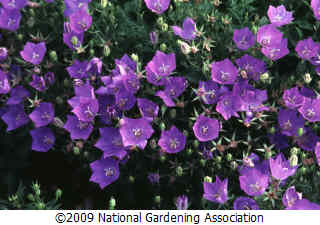Bellflower

There is enough diversity in the bellflower or
Campanula clan to ring just about any gardener's chimes. With bell-shaped, tubular or star-shaped flowers in shades of blue, white, pink and red, they have growth habits that range from low and creeping to tall and upright. Most of the garden-worthy choices are perennials, although there are some annuals and a biennial in the genus. And all are beautiful, even the few that are such vigorous spreaders and seeders that you may need to think twice about including them in your garden.
About This Plant
Bellflowers are hardy plants, with most types growing in Zones 4 to 8, even to zone 3 with reliable snow cover to provide insulation, but they'll sulk in the heat of the Deep South or Southwest. Peak bloom is in early to midsummer for most, but with deadheading you may get sporadic bloom throughout the summer and a second flush of flowers in fall. Bellflowers look lovely in many garden settings; their showy flowers and informal habit are the perfect fit in a cottage garden.
Special Features
Bellflowers fall into two categories, tall, upright growers that are good choices for a border or for cutting, and low growers that work well for edging or in rock gardens.
One of the most popular uprights is peachleaf bellflower
(Campanula persicifolia). Tall, 15 to 30 inch spikes of 1-1 ? inch, broadly bell-shaped flowers in shades of blue, pink, white and purple rise in early summer from basal clumps of leaves. Clustered bellflower
(C. glomerata) produces upwards facing heads of blossoms in purple or white in early summer on sturdy 18 inch stems. Milky bellflower
(C. lactiflora), 3 to 5 feet tall, and great bellflower
(C. latifolia), 4 to 5 feet tall, also both have upward-facing flowers.
Other upright growers are distinguished by their large, nodding blossoms. Spotted bellflower
(C. punctata) gets about 2 feet tall and bears pink, speckled, dangling flowers from midsummer to fall. 'Cherry Bells' is a popular cultivar. The hybrid 'Sarastro' has large, deep-purple, nodding bells on a 2 ? to 3 foot tall plant.
The low spreading bellflowers look nice trailing over the tops and between the stones of a dry rock wall. In early summer, Serbian Bellflower
(C. poscharskyana) spreads a wave of blue, 1-1", star-shaped flowers. Adriatic bellflower
(C. garganica) and Dalmatian bellflower
(C. portenschlagiana) are similar. For edging along a path, the low growing Carpathian harebell
(C. carpatica) is perfect. The cultivar 'Blue Clips' bears bright blue bells on 8-12" high plants over most of the summer. Even more floriferous is the sterile hybrid 'Samantha', which is covered in violet-blue, bowl-shaped blossoms above a 6" high clump of leaves.
The biennial Canterbury bells
(C. medium) is an old fashioned favorite, growing 12 to 30 inches tall and sporting boxy, bell-shaped flowers in shades of lilac, blue, pink and white. Start these plants from seed in midsummer for bloom the following year.
Site Selection
Most bellflowers do best if planted in full sun, but will also thrive in light shade. Plant in moist, well-drained soil that is high in organic matter. Some are spreaders, especially clustered bellflower and Serbian bellflower, so plant these where they'll have some room to roam. But steer clear of the aggressive Korean bellflower
(C. rapunculoides) which spreads so readily, it can become invasive.
Planting Instructions
Container plants can be set out any time during the growing season. Space most plants about a foot apart; the tall milky bellflower should have 24 inch spacing. Prepare the garden bed by using a garden fork or tiller to loosen the soil to a depth of 12 to 15 inches, then mix in a 2- to 4-inch layer of compost. Dig a hole twice the diameter of the pot the plant is in. Carefully remove the plant from its container and place it in the hole so the top of the root ball is level with the soil surface. Carefully fill in around the root ball and firm the soil gently. Water thoroughly.
Care
Apply a complete organic fertilizer and a thin layer of compost each spring, followed by a 2-inch layer of mulch to retain moisture and control weeds. Water plants during the summer if rainfall is less than 1 inch per week. Deadhead flowers to neaten plants and prevent self-sowing. On taller types, remove faded flowers individually, then cut back the flowering stalks to the base when all bloom is finished. With low growers, wait until the first flush of bloom is past, then shear back plants by half. Peachleaf bellflower can self-sow to the point of weediness if not deadheaded. Most bellflowers benefit from division every 3 to 5 years to keep them growing vigorously.






 There is enough diversity in the bellflower or Campanula clan to ring just about any gardener's chimes. With bell-shaped, tubular or star-shaped flowers in shades of blue, white, pink and red, they have growth habits that range from low and creeping to tall and upright. Most of the garden-worthy choices are perennials, although there are some annuals and a biennial in the genus. And all are beautiful, even the few that are such vigorous spreaders and seeders that you may need to think twice about including them in your garden.
There is enough diversity in the bellflower or Campanula clan to ring just about any gardener's chimes. With bell-shaped, tubular or star-shaped flowers in shades of blue, white, pink and red, they have growth habits that range from low and creeping to tall and upright. Most of the garden-worthy choices are perennials, although there are some annuals and a biennial in the genus. And all are beautiful, even the few that are such vigorous spreaders and seeders that you may need to think twice about including them in your garden.